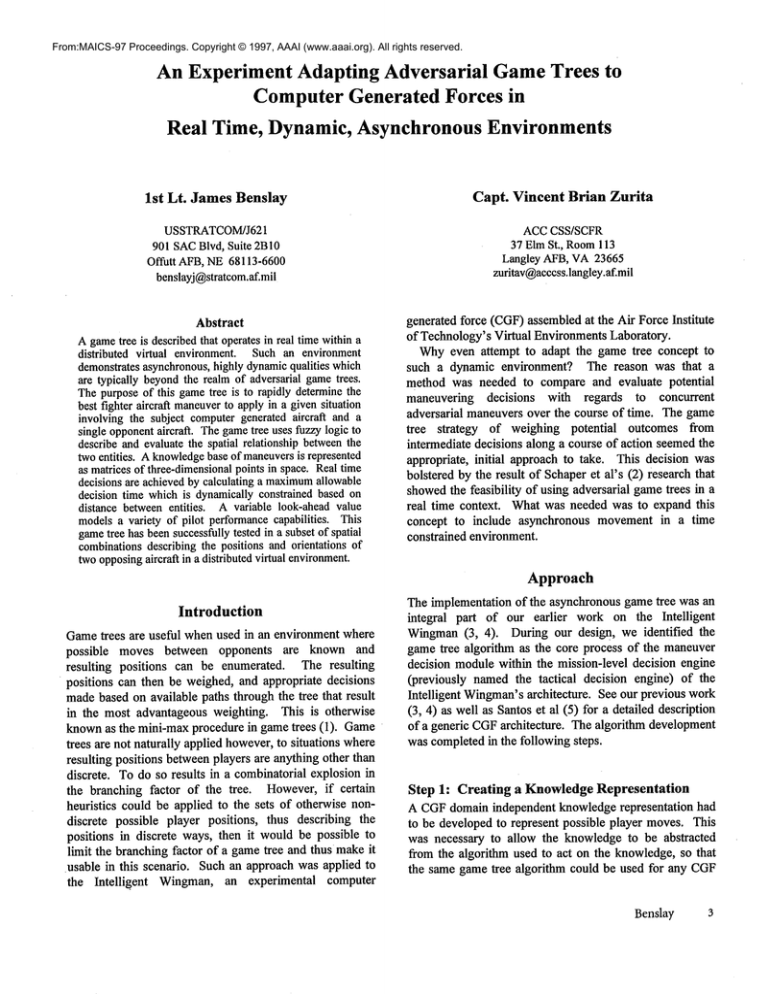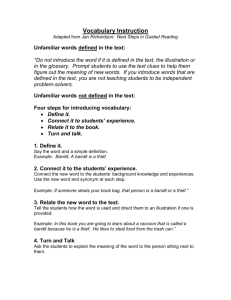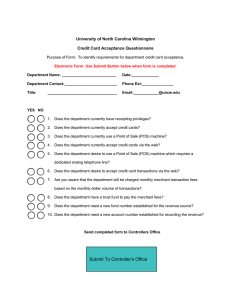
From:MAICS-97 Proceedings. Copyright © 1997, AAAI (www.aaai.org). All rights reserved.
An Experiment Adapting Adversarial GameTrees to
Computer Generated Forces in
Real Time, Dynamic, Asynchronous Environments
1st Lt. James Benslay
USSTRATCOM/J621
901 SACBlvd, Suite 21310
Offutt AFB,NE68113-6600
benslayj@stratcom.af.mil
Abstract
A gametree is describedthat operatesin real timewithin a
distributed virtual environment. Such an environment
demonstratesasynchronous,highly dynamicqualities which
are typically beyondthe realmof adversarial gametrees.
The purposeof this gametree is to rapidly determinethe
best fighter aircraft maneuver
to applyin a givensituation
involving the subject computergenerated aircraft and a
single opponentaircraft. Thegametree uses fuzzylogic to
describe and evaluate the spatial relationship betweenthe
two entities. Aknowledgebase of maneuvers
is represented
as matricesof three-dimensional
points in space. Real time
decisions are achievedby calculating a maximum
allowable
decision time whichis dynamicallyconstrained based on
distance betweenentities. A variable look-ahead value
modelsa variety of pilot performancecapabilities. This
gametree has beensuccessfullytested in a subsetof spatial
combinationsdescribing the positions and orientations of
twoopposingaircraft in a distributedvirtual environment.
Capt. Vincent Brian Zurita
ACC CSS/SCFR
37 ElmSt., Room113
Langley AFB, VA23665
zuritav@acccss.langley.af.mil
generated force (CGF)assembledat the Air Force Institute
of Technology’s Virtual EnvironmentsLaboratory.
Whyeven attempt to adapt the game tree concept to
such a dynamic environment? The reason was that a
method was needed to compare and evaluate potential
maneuvering decisions with regards to concurrent
adversarial maneuvers over the course of time. The game
tree strategy of weighing potential outcomes from
intermediate decisions along a course of action seemedthe
appropriate, initial approach to take. This decision was
bolstered by the result of Schaperet al’s (2) research that
showedthe feasibility of using adversarial gametrees in a
real time context. What was needed was to expand this
concept to include asynchronous movement in a time
constrained environment.
Approach
Introduction
Gametrees are useful when used in an environment where
possible moves between opponents are known and
resulting positions can be enumerated. The resulting
positions can then be weighed, and appropriate decisions
madebased on available paths through the tree that result
in the most advantageous weighting. This is otherwise
knownas the mini-max procedure in game trees (1). Game
trees are not naturally applied however,to situations where
resulting positions betweenplayers are anything other than
discrete. To do so results in a combinatorial explosion in
the branching factor of the tree. However, if certain
heuristics could be applied to the sets of otherwise nondiscrete possible player positions, thus describing the
positions in discrete ways, then it wouldbe possible to
limit the branching factor of a gametree and thus makeit
usable in this scenario. Such an approach was applied to
the Intelligent
Wingman, an experimental computer
The implementation of the asynchronous game tree was an
integral part of our earlier work on the Intelligent
Wingman(3, 4). During our design, we identified the
game tree algorithm as the core process of the maneuver
decision modulewithin the mission-level decision engine
(previously namedthe tactical decision engine) of the
Intelligent Wingman’sarchitecture. See our previous work
(3, 4) as well as Santos et al (5) for a detailed description
of a generic CGFarchitecture. The algorithm development
was completedin the following steps.
Step 1: Creating a Knowledge Representation
A CGFdomain independent knowledge representation had
to be developed to represent possible player moves. This
was necessary to allow the knowledge to be abstracted
from the algorithm used to act on the knowledge, so that
the same game tree algorithm could be used for any CGF
Benslay
3
regardless of the CGFtype. Wechose to build the moves,
or maneuvers, as simplistic directional graphs within a
three coordinate space. See Zurita (3) for an in-depth
discussion of this process. One key advantage to
representing the maneuversin this three coordinate space is
that the fundamental shape of the maneuver could be
rotated and scaled using standard formulas to achieve any
desired permutation of the basic maneuver. The
representation was then described in a simple, six columnar
format within a plain text file. The six columnsof the file
were x, y, and z coordinates, and the values for the CGF’s
heading, pitch, and roll at each of the points. Giventhese
six attributes, it is possible to describe the location of a
CGFwith regards to the coordinate origin, as well as the
intended orientation of the entity. By taking into account
an entity’s velocity vectors, applying a specific maneuver
representation, and then rotating and scaling the maneuver
by functions derived by the velocity vectors, we deduced
that we would be able to predict the location and
orientation of the CGFin a specified amountof time.
Step 2: Determining MaximumDecision Time
Given that we were using this approach to modelmaneuver
decision making in the highly dynamic and time critical
domain of combat aircraft
operations, we needed a
mechanismto determine the maximum
amount of time that
the gametree algorithm could use while searching for the
best possible solution. By doing so, the game tree
algorithm would never put the CGFentity in jeopardy by
taking too long to make a decision.
During our
incremental approach to the Intelligent
Wingman
experiment, we were limiting ourselves to offensive
maneuvers, i.e. those types of maneuvers used when the
Wingmanis pointed more or less towards the target
aircraft, and the target aircraft is moreor tess pointed away
from the Wingman.For these situations, we calculated the
minimumtime it would take the Wingman
to intercept the
target aircraft using fictitious data in place of classified
missile flight parameters. This minimumintercept time
was then divided by a user defined value, the result being
the maximumallowable time the game tree algorithm
could use to makea decision. The reason for adding this
user def’med divisor was to prevent the algorithm fxom
4
MAICS-97
using the entire time to intercept to makea decision. By
giving the user control of this value, it allows flexible
scaling of the performance factors in the CGF’sdecision
making. In addition to the division value, an absolute
minimum
timing value is also available to the user in order
to specify that should the resulting maximum
decision time
be very short (less than 1 second), the algorithm mayover
ride its calculation and use the minimum
specified decision
time.
For example, during our initial experiments, the
Wingman
and a bandit were started at 20 miles apart on an
offensive intercept. Using the aircraft velocities and our
fictitious missile data, an intercept time of approximately
400 seconds was calculated. Weused a division factor of
100, thereby limiting the algorithm’s maximum
decision
time to 4 seconds (whichis reasonable according to fighter
pilots we interviewed). The absolute minimumtime was
set to 1 second.
Step 3: Constructing the GameTree
The actual gametree was constructed by using the bandit’s
knownmaneuversfor a defensive approach as the first tier
nodes, and then combining all the wingman’s maneuvers
for an offensive approach as the second tier nodes. As a
result of this approach, the ply of the basic tree will never
exceed 2 (not including the depth of the evaluation
branches discussed in Step 6).
Since the algorithm was written to accept any number
of maneuverswhenconstructing the tree, the namesof the
known maneuvers as well as their data files were
established at programstartup by an initialization file. To
keep the algorithm complexity low, we elected to not
accept dynamically defined maneuversafter programstart.
Also during our initial tests, we assumedthat the "pilots"
of both CGFswould have equal maneuvering knowledge,
hence we used the same set of offensive and defensive
maneuvers for each CGF.
As a componentof the maneuvernodes of each tier, the
maneuver points that represented that maneuver were
attached. This would be a necessary step in determining
the location of each entity along their particular maneuver.
Refer to Figure 1 for an exampleof the modifiedtree.
Game
Tree
Bandit
Maneuvers
(defensive)
(
aneuver
Lists
Wingman
Maneuvers
~
(offensive)
looking x seconds
intofuture.
C
Figure 1. Anexampleof our asynchronousgametree, showinglists for maneuverpoints and lists
snapshots.
Step 4: Determining Discrete Look-Ahead Values
It was an initial requirementthat the Intelligent Wingman’s
performance capabilities be completely scaleable (6).
this end, fuzzy logic term sets, membershipfunctions, and
inferencing were used to assign imprecise descriptions of
the Wingman’s abilities
(3, 4, 5, 6). The game tree
algorithm then used the values of certain variables defined
over fuzzy logic term sets as iterative multipliers to
determine how far ahead that particular
Wingman
instantiation wouldbe able to accurately predict both his
and the bandit’s position and orientation given a pair of
chosen maneuvers. For our tests, the evaluations of the
fuzzy values resulted in look-ahead values of 1, 2 or 3
seconds. Whatthis meansis that for each breadth wise pass
through the gametree, a Wingman
with a look-ahead value
of 3 seconds would get to look 3 more seconds into the
future of the maneuvercombination. Hence, after 2 passes
of the tree, the Wingman
with a look-ahead of 3 would be
6 seconds into the maneuver, whereas the Wingmanwith a
look-ahead of 1 would only be 2 seconds into the
maneuver.Thus we were able to establish better foresight
performance
for those Wingman who had higher
performanceratings.
Step 5: Determining Discrete Player Positions
By knowing the combination of chosen maneuvers and the
aircraft velocities, we were able to create "snapshots" of
player positions and orientations with regards to time as
for evaluation
calculated by the product of the look-ahead value and the
number of passes through the gametree. These snapshots
were then used to represent the discrete player positions
necessary to plug into the evaluation nodes of the game
tree. As it turned out, understanding and implementingthe
multiple coordinate system transformations in preparation
of evaluating the resulting positions endedup being a large
portion of our effort. Withoutpaying careful attention to
the order and type of matrix transformations required, any
resulting position evaluations would of course be
meaningless. Refer to Zurita (3) for a detailed description
of the required coordinate systemtransformations.
Step 6: Evaluating Resulting Player Positions
It is beyondthe scopeof this paper to describe in detail our
process for identifying and implementing the fuzzy logic
term sets and membership functions that we used to
evaluate the player positional snapshots. Suffice it to say
that we interviewed available fighter pilots and thereby
def’medthe following term sets:
1) Relative Target Latitude,
2) Relative Target Longitude,
3) Relative Target Altitude,
4) Rangeto Designated Target,
5) Target Aspect, and
6) Firing Range.
Wethen created a reasoning schema (4) to outline the
fuzzy inferencing rules necessary to affect the Evaluation
termset.
Movingbreadth-wise through the game tree, player
positions were evaluated by one maneuver pairing at a
Benslay
5
time, so long as there was both a combination left to
evaluate and sufficient
time remained to make the
evaluation. A single evaluation involved fuzzifying the
exact coordinate locations according to the previously
mentioned term sets, and then allowing the inferencing
engine to evaluate all the applicable rules. Weused a
standard, center of gravity defuzzification technique to
derive a single, quantifiable result from the inferencing
engine. This value was used as the resulting player
positional score.
Experiment
Results
In order to test our algorithm, we built in extensive data
reporting utilities that would allow us to examine all
aspects of the game tree construction and evaluation.
Below is a simplified example of output data from one
experiment. It details, in the following order: 1) pilot
profile information, 2) look ahead calculations, 3) both
Wingmanand bandit initial locations and resulting
orientations from the opposite perspective, 4) orientation
calculations for fuzzification, 5) decision timing criteria,
and 6) the resulting evaluations and a concluding decision
maneuver.
GAME TREE DUMP DATA
PP MembershipSection:
Fact Assertion & Inferencing Time:
pp:
PP Membershipin ’Weak’:
PP Membershipin ’Average’:
PP Membershipin ’Strong’:
PP Membership
in ’Elite’:
Determine Lookahead Section:
Calculation Time:
TimeStep:
Acft Transformation Section:
(Units: Feet &Degrees)
FWPos.x:
FW_Pos.y:
FWPos.z:
FW_Pos.psi:
FWPos.theta:
FW_Pos.phi:
FW_Pos.linear_velocity.x:
FWPos.linearvelocity.y:
FW_Pos.linearvelocity.z:
Bandit Pos.x:
Bandit_Pos.y:
Bandit Pos.z:
Bandit_Pos.psi:
Bandit Pos.theta:
Bandit_Pos.phi:
6 MAICS-97
0.044459
92
0
0
0.2
0.2
4.4e-05
3
0
0
2000
5
10
0
475
475
0
75000
2000
2000
5
0
0
Bandit_linearvelocity.x:
Bandit_linear_velocity.y:
Bandit_linear_velocity.z:
FWTrans Pos.x:
FW_Trans_Pos.y:
FWTrans Pos.z:
FW_Trans_Pos.psi:
FWTrans Pos.theta:
FW_Trans_Pos.phi:
Bandit Trans Pos.x:
Bandit_Trans_Pos.y:
Bandit Trans Pos.z:
Bandit_Trans_Pos.psi:
Bandit Trans Pos.theta:
Bandit_Trans_Pos.phi:
Determine BFMGeometry Section:
Fact Assertion & Inferencing Time:
RTLO:
m(on the nose_of):
re(even_with):
RTLA:
RTA:
m(even_with):
TAS:
m0aot):
FIR:
Score:
m(advantages):
BFMGeometry State:
Tree Construction Section
WingmanPosture State:
Bandit Posture State:
Decision TimeSection:
Units: Time(seconds),Distance(feet):
Timeto Calculate Decision Time:
Distance to Bandit:
Weapon Employment Zone
(hard codedfor now):
Min Allowable Decision Time
(via parameter):
Time to WeaponOptimumRange:
Total TimeDivision Factor
(via parameter):
MaxAllowable Decision Time
(via calc):
Total Evaluation Time:
Scoring Only Time:
Total ManeuverNodes Considered:
Longest Single Evaluation Time:
Highest Score:
Chosen Wingman Maneuver
450
50
0
74888.9
4544.29
0
0
0
0
73753.8
4444.99
13023.6
0
0
0
0.053217
79.4311
0.918379
0
3.3965
9.99641
0.909124
176.528
0
75026.7
94.6746
0.986687
Offensive
Offensive
Defensive
9.3e-05
75026.7
58080
1
466.588
100
4.66588
3.11382
2.98858
312
0.065952
94.8417
bfm.Close
Shortfalls
of the Asynchronous
Game Tree
To limit the scope of our effort, the gametree currently
models only offensive maneuvering situations.
This
obviously falls short of modelinga real world environment
in which opposing CGFsmayalso encounter each other in
high aspect or defensive maneuvering settings.
Incorporating high aspect and defensive maneuvers into
the knowledgebase will allow the asynchronous gametree
to more accurately model an actual combatenvironment.
Additionally, there exists no separate knowledgebase of
maneuvers appropriate for a true adversarial CGF. We
used the same offensive and defensive F-15 maneuversfor
both the Intelligent
Wingmanas well as its foe. By
developing a set of maneuvers that models a potential
adversarial CGF(i.e. a MiG-29), this shortfall may
overcome.
Finally, the current algorithm doesn’t employa true
mini-max procedure in that it doesn’t maximize the
adversary’s move. By allowing such a maximization, the
mini-max procedure may be realized on this game tree,
thereby enhancingits capabilities.
.
.
Computer Generated Forces. MSthesis, School of
Engineering, U.S. Air Force Institute of Technology.
Santos, E. Jr.; Banks, S. B.; Stytz, M. 1996.
Engineering Intelligent ComputerGenerated Forces,
Technical Report, School of Engineering, U.S. Air
Force Institute of Technology.
Edwards, Capt. M. 1996. The Automated Wingman:
A Computer Generated Companion for Users of DIS
Compatible Flight Simulators. MSthesis, School of
Engineering, U.S. Air Force Institute of Technology.
Conclusion
Wehave demonstrated the ability to adapt a static game
tree to the highly dynamic, asynchronous environment
typically found with combat fighter aircraft computer
generated forces (CGFs).The positive results of our initial
tests showedthat such an asynchronousgametree could in
fact perform well in such an environment when the
maximum processing
time per decision
cycle is
constrained. This asynchronous game tree algorithm can
be easily applied to a CGFof any domain(land, sea, air,
space) by incorporating specifically-tailored
knowledge
bases of maneuvers for such a CGF. The existing game
tree may be enhanced by increasing the breadth of the
knowledgebase to include more high aspect, offensive,
and defensive maneuversfor both the subject aircraft and
its adversaries,
and allowing maximization of the
adversary’s moveto effect a true mini-maxprocess.
References
1. Winston, Patric Henry. eds. 1993. Artificial
Intelligence, 3rd Ed. Reading, MA:Addison-Wesley.
2. Schaper, G.; Pandari, S.; Singh, M.1994. Lookahead
Limits of Intelligent Player. In Proceedings of the
Fourth Conference on ComputerGenerated Forces and
Behavioral Representation, 401-410. IST
for
3. Zurita, Capt. V.B. 1996. An Architecture
Computer Generated Forces in Complex Distributed
Virtual Environments.
MS thesis, School of
Engineering, U.S. Air Force Institute of Technology.
4. Benslay, 1st Lt. J. 1996. A Domain Independent
Framework for Developing
Knowledge Based
Benslay
7





